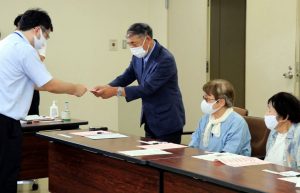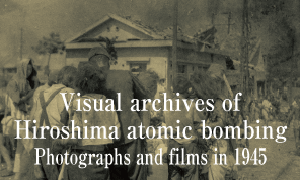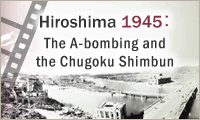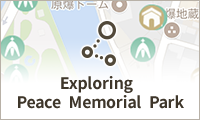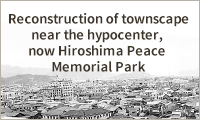Documenting Hiroshima 80 years after A-bombing: August 2, 2021, area of eligibility for relief from “black rain” expanded
Jun. 2, 2025
Residents’ court victory pushes national government to act
by Michio Shimotaka, Staff Writer
On August 2, 2021, 10 people including Masaaki Takano, 87, a resident of Hiroshima City’s Saeki Ward, received the Atomic Bomb Survivor’s Certificate at the Hiroshima City Hall for their exposure to “black rain,” composed of radioactive and other materials, that had fallen after the atomic bombing of Hiroshima. All members of the group had failed to qualify for relief to that point based on the reasoning that they had been outside the so-called “heavy rainfall area” at the time of the bombing. Their joy at having pushed the national government to act as a result of the trial was immense. But one remarked, “Rather than believe the issue was resolved, I had the feeling that was just the beginning.”
On August 6, 1945, Mr. Takano had been exposed to the black rain on his return back home from the branch of a national school located in the mountainous area of the present-day town of Yuki-cho in Hiroshima’s Saeki Ward, located around 20 kilometers northwest of the hypocenter. “I suffered from a high fever and diarrhea among other symptoms and had a persistent bloody nose until I was in high school.” He began to suspect that his symptoms might be related to the black rain.
However, in 1976, the Japanese government limited eligibility for relief to an oval-shaped, heavy rainfall area measuring around 19 kilometers (on the longest side) by 11 kilometers (shortest side) spreading in the northwest direction from the hypocenter, with the part of Yuki-cho where Mr. Takano had been living not included in the designated area. The government had refused to expand the designated area based on a 1980 advisory report issued by the Conference for Fundamental Problems of Measures for the Victims of the Atomic Bombs (Kihon-kon), which stated, “Designation of the area affected by the atomic bombing should be made only when there is a scientific and rational basis for doing so.”
Demand to expand area six-fold
In 2010, the Hiroshima City government, along with the Hiroshima Prefectural government and other parties, demanded that the national government expand the area of eligibility for relief by around six times the original size based on the results of a survey looking into health awareness among approximately 37,000 citizens, and other related information. In 2012, while recognizing the insistence that those who had been exposed to the black rain outside the designated area also suffered from physical and psychological problems similar to those experienced by A-bomb survivors, Japan’s Ministry of Health, Labour and Welfare rejected expansion of the designated area based on a report from an expert panel critical of the Hiroshima City survey.
In 2015, applications to the city and prefectural governments for the Atomic Bomb Survivor’s Certificate submitted by 64 people, including Mr. Takano, were turned down. As a result, the group filed a class-action lawsuit with the Hiroshima District Court seeking to have the rejection overturned. “We only wanted to know what the truth was, although we knew it would take time,” said Mr. Takano. In effect, the lawsuit aimed to press the national government to expand the designated area of eligibility.
In the lawsuit, residents outside the designated area expressed their growing concerns. With the sentiments, “A white shirt I was wearing at the time was marked by black spots where the raindrops had hit” and “I suffer from functional disorders of my liver and respiratory organs,” the residents communicated details of their memories and the health effects they experienced, insisting that the national government’s designation of the area’s boundary was arbitrary. The defendant side argued, “There is no objective evidence of exposure to the black rain.”
Atomic Bomb Survivor’s Certificate issued to all plaintiffs
In 2020, the district court ruling ordered all 84 plaintiffs, including those who had filed an additional lawsuit, to be issued the certificate. The court’s ruling indicated that the determination of whether or not there had been exposure to the black rain should be judged by thorough examination of “whether the statements and other information indicating there had been black-rain exposure were reasonable,” rather than using the specific rainfall area as the basis for recognition.
The defendant side appealed the ruling to a higher court in keeping with the national government’s position, but a High Court ruling in July 2021 upheld the judgment of the lower district court. Nearly six years after the lawsuit, 19 of the plaintiffs had already died. Then-Prime Minister Yoshihide Suga decided not to appeal the case to Japan’s Supreme Court on the grounds that “the plaintiffs should be supported by a return to the principles espoused in the Atomic Bomb Survivors Relief Law,” with the Cabinet approving a ministerial statement for providing relief to “other people in circumstances similar to those of the plaintiffs.”
According to the Ministry of Health, Labour and Welfare, during the period from fiscal 2022, when the new criteria for qualification began, until the end of fiscal 2024, certificates had been issued to 7,435 people. Mr. Takano, who served as leader of the plaintiffs, reflected on the lawsuit journey. “What it means is that once the atomic bomb was used, it created still-unresolved issues nearly 80 years later.” Even now, the Hiroshima District Court continues to address lawsuits filed by local residents in Hiroshima Prefecture whose certificate applications based on the new standards have been rejected, among other cases.
(Originally published on June 2, 2025)

